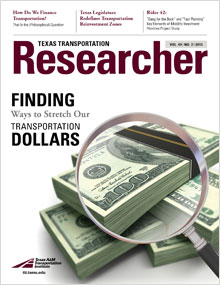
The term hasn’t made it into daily conversation yet, but “transportation reinvestment zone” (TRZ) will likely become a familiar phrase among Texas taxing authorities soon. The 2013 Texas Legislature approved several bills that ease restrictions and expand the use of this new strategy for financing transportation.
Essentially, the legislation makes it easier to establish a TRZ to finance an infrastructure project. Here’s how TRZs typically work: a taxing authority establishes a geographical area, or zone, where the anticipated increase in property values would be used to pay back the long-term loan that funded a project in the zone.
The 2013 legislation lifts previous restrictions limiting TRZs to highways or road projects within municipalities or counties. Originally approved by legislation in 2007, TRZs can now be established by port authorities and navigation districts and can finance improvements or construction of rail, transit, ferries, airports and even parking lots. Lawmakers also approved county-level energy TRZs to fund road-maintenance projects in the vast oil boom areas of the state.
“Compared to years earlier, the number of transportation reinvestment zones across the state increased last year, and I think a lot more entities will be considering them now,” says Rafael Aldrete, regional manager for the Texas A&M Transportation Institute’s (TTI’s) Research and Implementation Program offices in San Antonio and El Paso.
Aldrete was involved with TRZs early on when, in 2008, he helped assess the revenue potential of a zone to fund eight roadway projects located in El Paso. The study led to the establishment of one of the first TRZs in Texas. Since then, a handful of other TRZs have been established in the state, but overall, reinvestment zones have seen limited use.
“It’s important to point out that they really are not suited for every situation,” Aldrete warns. “Yes, they give another local funding option for a transportation project, but taxing authorities need to do a lot of homework to determine if they should establish a TRZ. And that’s the kind of work that TTI has been involved with.”

Aldrete and other TTI employees have performed numerous corridor projections for taxing entities considering TRZs. One such sponsor was the City of El Paso. TTI assisted the city in the implementation of a TRZ. The Camino Real Regional Mobility Authority (CRRMA) then used the City of El Paso’s TRZ to issue debt for an important regional project.
“Originally, the legislation for reinvestment zones had some provisions that made taxing entities a little nervous about tying up future revenues, but legislative fixes over the past couple of sessions have alleviated a lot of concerns. These legislative tweaks have generated a renewed interest in TRZs across the state,” says CRRMA Executive Director Raymond Telles. “I’ve been asked to speak to groups in Austin, Corpus Christi and Dallas about TRZs. Each of their situations is different.”
Telles says he would advise entities considering TRZs to project prospective revenues conservatively. “It’s a lot easier when you have more money coming in than you were anticipating than to deal with the opposite situation,” he says.
